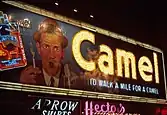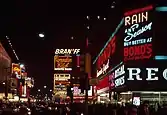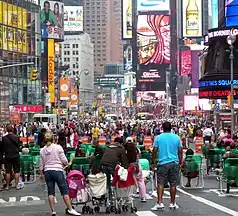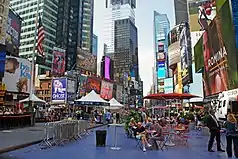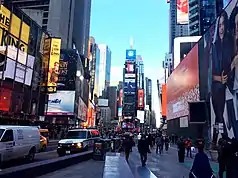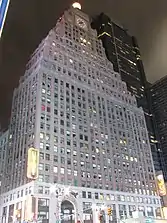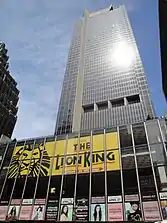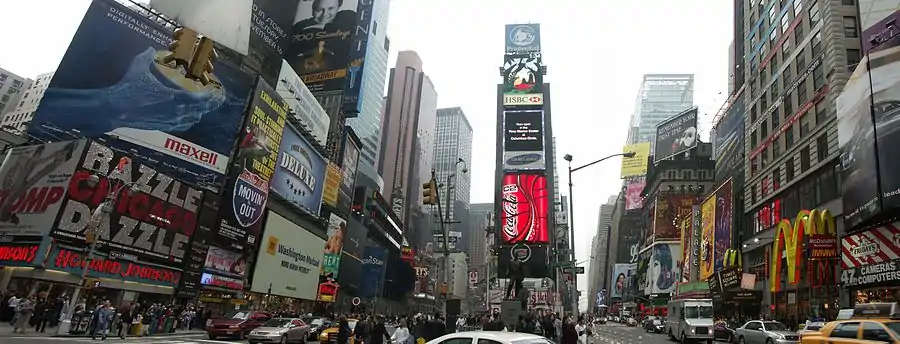Times Square
Times Square is a major commercial intersection, tourist destination, entertainment hub, and neighborhood in Midtown Manhattan, New York City. It is formed by the junction of Broadway, Seventh Avenue, and 42nd Street. Together with adjacent Duffy Square, Times Square is a bowtie-shaped space five blocks long between 42nd and 47th Streets.
Times Square | |
|---|---|
Neighborhood in Manhattan | |
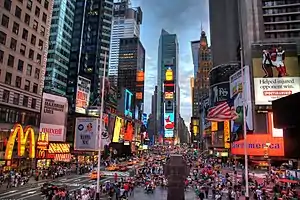 | |
 Looking south (top) and north (bottom) | |
| Nickname(s): The Center of the Universe The Crossroads of the World The Great White Way The Heart of the World | |
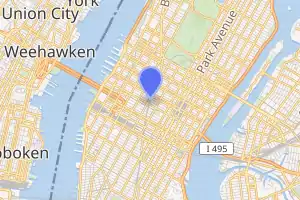 Location in New York, New York | |
| Coordinates: 40.757°N 73.986°W | |
| Country | United States |
| State | |
| City | New York |
| Borough | Manhattan |
| Community District | Manhattan 5[1] |
| Boundaries | Broadway, 7th Avenue, 42nd and 47th Streets |
| Subway services | 1, 2, 3, 7, <7>, A, C, E, N, Q, R, W, and S trains at Times Square–42nd Street station |
| Bus routes | M7, M20, M42, M50, M104 |
| Historical features | Duffy Square George Michael Cohan statue One Times Square |
Brightly lit at all hours by numerous billboards and advertisements as well as businesses offering 24/7 service, Times Square is sometimes referred to as "the Crossroads of the World",[2] "the Center of the Universe",[3] "the heart of the Great White Way",[4][5][6] and "the heart of the world".[7]
One of the world's busiest pedestrian areas,[8] it is also the hub of the Broadway Theater District[9] and a major center of the world's entertainment industry.[10] Times Square is one of the world's most visited tourist attractions, drawing an estimated 50 million visitors annually.[11] Approximately 330,000 people pass through Times Square daily,[12] many of them tourists,[13] while over 460,000 pedestrians walk through Times Square on its busiest days.[7] The Times Square-42nd Street station has consistently ranked as the busiest in the New York City Subway system, transporting more than 200,000 passengers daily.[14]
Formerly known as Longacre Square, Times Square was renamed in 1904 after The New York Times moved its headquarters to the then newly erected Times Building, now One Times Square.[15] It is the site of the annual New Year's Eve ball drop, which began on December 31, 1907, and continues to attract over a million visitors to Times Square every year,[16] in addition to a worldwide audience of one billion or more on various digital media platforms.[17]
Times Square, specifically the intersection of Broadway and 42nd Street, is also the eastern terminus of the Lincoln Highway, the first road across the United States for motorized vehicles.[18]
A proposal to build a gambling casino was submitted in October 2022 as a joint venture between casino operator Caesars Entertainment and commercial property developer SL Green; a protracted approval process would follow, with no guarantee of approval being granted by New York State.[19]
Geography
Times Square functions as a town square, but is not geometrically a square; it is closer in shape to a bowtie, with two triangles emanating roughly north and south from 45th Street,[20] where Seventh Avenue intersects Broadway. The area is bounded by West 42nd street, West 47th street, 7th Avenue, and Broadway. Broadway runs diagonally, crossing through the horizontal and vertical street grid of Manhattan laid down by the Commissioners' Plan of 1811, and that intersection creates the "bowtie" shape of Times Square.[21][22]
Times Square is the official name of the southern triangle,[23] below 45th Street, but the northern triangle is officially Duffy Square. It was dedicated in 1937 to World War I chaplain Father Francis P. Duffy of the 69th New York Infantry Regiment, and is the site of a memorial to him. There is also a statue of composer and entertainer George M. Cohan,[24] and the TKTS discount ticket booth for Broadway and off-Broadway theaters.
History
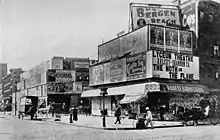
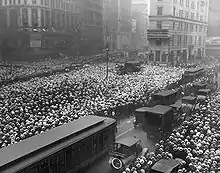
Early history
When Manhattan Island was first settled by the Dutch, three small streams united near what is now 10th Avenue and 40th Street. These three streams formed the "Great Kill" (Dutch: Grote Kil). From there the Great Kill wound through the low-lying Reed Valley, known for fish and waterfowl,[25] and emptied into a deep bay in the Hudson River at the present 42nd Street.[26] The name was retained in a tiny hamlet, Great Kill, that became a center for carriage-making, as the upland to the south and east became known as Longacre.[27]
Before and after the American Revolution, the area belonged to John Morin Scott, a general of the New York militia, in which he served under George Washington. Scott's manor house was at what is currently 43rd Street, surrounded by countryside used for farming and breeding horses. In the first half of the 19th century, it became one of the prized possessions of John Jacob Astor, who made a second fortune selling off lots to hotels and other real estate concerns as the city rapidly spread uptown.[28]
By 1872, the area had become the center of New York's horse carriage industry. The locality had not previously been given a name, and city authorities called it Longacre Square after Long Acre in London, where the horse and carriage trade was centered in that city.[29] William Henry Vanderbilt owned and ran the American Horse Exchange there. In 1910, it became the Winter Garden Theatre.[30]
As more profitable commerce and industrialization of Lower Manhattan pushed homes, theaters, and prostitution northward from the Tenderloin District, Longacre Square became nicknamed the Thieves Lair for its rollicking reputation as a low entertainment district. The first theater on the square, the Olympia, was built by cigar manufacturer and impresario Oscar Hammerstein I.[31] According to Gotham: A History of New York City to 1898, "By the early 1890s this once sparsely settled stretch of Broadway was ablaze with electric light and thronged by crowds of middle- and upper-class theatre, restaurant and cafe patrons."[32]
1900s–1930s
In 1904, New York Times publisher Adolph S. Ochs moved the newspaper's operations to a new skyscraper on 42nd Street at Longacre Square, on the site of the former Pabst Hotel, which had existed on the site for less than a decade since it opened in November 1899.[33] Ochs persuaded Mayor George B. McClellan Jr. to construct a subway station there, and the area was renamed "Times Square" on April 8, 1904.[34] Just three weeks later, the first electrified advertisement appeared on the side of a bank at the corner of 46th Street and Broadway.[35] The north end later became Duffy Square, and the former Horse Exchange became the Winter Garden Theatre, constructed in 1911.[36]
The New York Times moved to more spacious offices one block west of the square in 1913 and sold the building in 1961.[34] The old Times Building was later named the Allied Chemical Building in 1963.[37] Now known simply as One Times Square, it is famed for the Times Square Ball drop on its roof every New Year's Eve.
In 1913, the Lincoln Highway Association, headed by entrepreneur Carl G. Fisher, chose the intersection of 42nd Street and Broadway (at the southeast corner of Times Square) to be the Eastern Terminus of the Lincoln Highway. This was the first road across the United States, which originally ran 3,389 miles (5,454 km) coast to coast through 13 states to its western terminus in Lincoln Park in San Francisco.[38][39]
Times Square grew dramatically after World War I.[40] It became a cultural hub full of theatres, music halls, and upscale hotels.[40]
Times Square quickly became New York's agora, a place to gather to await great tidings and to celebrate them, whether a World Series or a presidential election.
— James Traub, The Devil's Playground: A Century of Pleasure and Profit in Times Square
Advertising also grew significantly in the 1920s, growing from $25 million to $85 million over the decade.[41] For example, the Wrigley Spearmint Gum sign, possibly the biggest electric sign "in the world," cost $9,000 per month to rent.[42] Some contemporary critics, such as Thorstein Veblen[43] and G. K. Chesterton,[44] disliked the advertising at Times Square. Fritz Lang, after seeing Times Square in 1923, used it as inspiration for his dark industrial film Metropolis.[43]
Entertainment icons such as Irving Berlin, Charlie Chaplin, and Fred Astaire were closely associated with Times Square in the 1910s, 1920s, and 1930s. However, it was also during this period that the area began to be besieged by crime and corruption, in the form of gambling and prostitution; one case that garnered huge attention was the arrest and subsequent execution of police officer Charles Becker.[45]
1930s–1950s
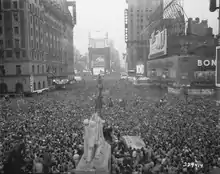
The general atmosphere of Times Square changed with the onset of the Great Depression in the early 1930s. City residents moved uptown to cheaper neighborhoods, and many popular theaters closed, replaced by saloons, brothels, "burlesque halls, vaudeville stages, and dime houses".[46] The area acquired a reputation as a dangerous and seedy neighborhood in the following decades.[47]
Nevertheless, Times Square continued to be the site of the annual ball drop on New Year's Eve. The ball drop was placed on hiatus for New Year's Eve in 1942 and 1943 due to lighting restrictions during World War II. Instead, a moment of silence was observed at midnight in Times Square, accompanied by the sound of chimes played from sound trucks.
On May 8, 1945, a massive crowd celebrated Victory in Europe Day in Times Square;[48] and on August 15, 1945, the largest crowd in the history of Times Square gathered to celebrate Victory over Japan Day.[49] The victory itself was announced by a headline on the "zipper" news ticker at One Times Square, which read "OFFICIAL *** TRUMAN ANNOUNCES JAPANESE SURRENDER ***
Decline
From the 1960s to the early 1990s, the seediness of the area, especially due to its go-go bars, sex shops, peep shows, and adult theaters, became an infamous symbol of the city's decline.[50] As early as 1960, 42nd Street between Seventh and Eighth avenues was described by The New York Times as "the 'worst' [block] in town".[51] Later that decade, Times Square was depicted in Midnight Cowboy as gritty, depraved, and desperate. Conditions only worsened in the 1970s and 1980s, as did the crime in the rest of the city. In the mid-1980s, the area bounded by 40th and 50th Streets and Seventh and Ninth Avenues saw over 15,000 crime complaints per year.[52] The block of 42nd Street between Seventh and Eighth avenues had 2,300 crimes per year in 1984, of which one-fifth were felonies.[53][54]
In this era, formerly elegant movie theaters began to show porn, and hustlers were common.[55] The area was so abandoned at one point during the time that the entire Times Square area paid the city only $6 million in property taxes (about $13 million in 2020).
1980s building boom
In the 1980s, a commercial building boom began in the western parts of Midtown as part of a long-term development plan developed under mayors Ed Koch and David Dinkins. These included office buildings such as 1540 Broadway, 1585 Broadway, and 750 Seventh Avenue, as well as hotels such as the Macklowe Hotel, Marriott Marquis, Crowne Plaza, and DoubleTree Suites.[56] By 1986, New York City Planning Commission (CPC) was considering enacting regulations that would have forced new buildings along Times Square to include bright signage as well as deep setbacks.[57] The CPC adopted a planning regulation in 1987, which required large new developments in Times Square to set aside about 5 percent of their space for "entertainment uses".[58][lower-alpha 1] The regulation also required new buildings on Times Square to include large, bright signs.[58] The buildings at 1540 Broadway, 1585 Broadway, and 750 Seventh Avenue were completed at with the beginning of the early 1990s recession, when 14.5 percent of Manhattan office space was vacant.[59] Furthermore, some 9 million square feet (840,000 m2) of office space in the western section of Midtown had been developed in the 1980s, of which only half had been leased.[60][61] Consequently, 1540 Broadway was completely empty, while 1585 Broadway and 750 Seventh Avenue had one tenant each, despite the buildings having over 2 million square feet (190,000 m2) of office space between them.[59][62] Entertainment conglomerate Bertelsmann bought 1540 Broadway in 1992,[63][64] spurring a revival of Times Square in the early 1990s.[65][66] This was hastened when financial firm Morgan Stanley bought 1585 Broadway in 1993,[67] followed by 750 Seventh Avenue in 1994.[68]
42nd Street Redevelopment, further revitalization
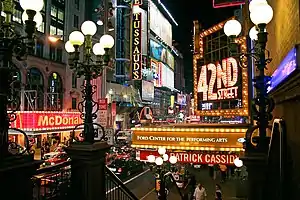
The Empire State Development Corporation (ESDC), an agency of the New York state government, had proposed redeveloping the area around a portion of West 42nd Street in 1981.[69] Four towers designed by Philip Johnson and John Burgee were to be built around 42nd Street's intersections with Broadway and Seventh Avenue.[70][71] These towers would have been redeveloped by George Klein of Park Tower Realty, though the Prudential Insurance Company of America joined the project in 1986.[72][73][74] Furthermore, as part of the West Midtown special zoning district created in 1982, the New York City government had allowed new buildings in Times Square to be developed with an increased floor area ratio. To ensure the area would not be darkened at nightfall, the city passed zoning regulations that encouraged developers to add large, bright signs on their buildings.[70][75]
In 1990, the State of New York took possession of six of the nine historic theaters on 42nd Street, and the New 42nd Street non-profit organization was appointed to oversee their restoration and maintenance. The theaters underwent renovation for Broadway shows, conversion for commercial purposes, or demolition.[76] Opposition to the towers on Times Square, along with Prudential and Park Tower's inability to secure tenants for the proposed buildings,[77] led government officials to allow Prudential and Park Tower to postpone the project in 1992.[71][78] By then, Prudential had spent $300 million on condemning the sites through eminent domain.[79] The partners retained the right to develop the sites in the future,[80] and the ESDC's zoning guidelines remained in effect.[70] In exchange for being permitted to delay construction of the sites until 2002, Prudential and Park Tower were compelled to add stores and install large signage on the existing buildings.[81]
In 1992, the Times Square Alliance (formerly the Times Square Business Improvement District, or "BID" for short), a coalition of city government and local businesses dedicated to improving the quality of commerce and cleanliness in the district, started operations in the area.[82] In 1998, the alliance opened a tourist information center in the former Embassy Theatre at 1560 Broadway;[83] the information center operated until 2014.[84]
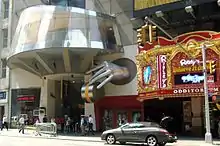
In the mid-1990s, Mayor Rudolph Giuliani led an effort to clean up the area, an effort that is described by Steve Macek in Urban Nightmares: The Media, the Right, and the Moral Panic Over the City: Security was increased, pornographic theatres were closed, and "undesirable" low-rent residents were pressured to relocate, and then more tourist-friendly attractions and upscale establishments were opened. Advocates of the remodeling claim that the neighborhood is safer and cleaner. Detractors have countered that the changes have homogenized or "Disneyfied" the character of Times Square and have unfairly targeted lower-income New Yorkers from nearby neighborhoods such as Hell's Kitchen.[85][86] The changes were shaped in large part by the actions of The Walt Disney Company, which bought and restored the New Amsterdam Theatre after several attempts at redevelopment had failed. As part of a contract with Disney, officials from the city and state evicted the pornographic theaters and contracted with Madame Tussauds and AMC Theatres to move onto 42nd Street. This spurred the construction of new office towers, hotels, and tourist attractions in the area.[87]
Prudential and Klein dissolved their partnership for the four office-building sites at Times Square's southern end in 1996.[88][89] The same year, Douglas Durst acquired the site at the northeast corner of Broadway and 42nd Street,[90] and he developed 4 Times Square there.[91] The northwest corner of Seventh Avenue and 42nd Street was taken by Reuters, which enlisted Rudin Management as its development partner and built 3 Times Square on that corner;[92][93] that building opened in 2001.[94] In 1998, a joint venture of Klein, The Blackstone Group, and Boston Properties won the right to acquire the sites at the southwest and southeast corners of 42nd Street and Seventh Avenue for $330 million.[95][96] 5 Times Square was completed on the southwest-corner site in 2002,[97][98] and Times Square Tower opened on the southeast-corner site in 2004.[99]
Effects
Times Square now boasts attractions such as ABC's Times Square Studios, where Good Morning America is broadcast live; competing Hershey's and M&M's stores across the street from each other, and multiple multiplex movie theaters. Additionally, the area contains restaurants such as the Bubba Gump Shrimp Company, a seafood establishment; Planet Hollywood Restaurant and Bar, a theme restaurant; and Carmine's, serving Italian cuisine. It has also attracted several large financial, publishing, and media firms to set up headquarters in the area. A larger presence of police has improved the safety of the area.[76]
The theatres of Broadway and the huge number of animated neon and LED signs have been one of New York's iconic images as well as a symbol of the intensely urban aspects of Manhattan. Since 1987 such signage has been mandated by zoning ordinances that require building owners to display illuminated signs, the only district in New York City with this requirement.[100][101] The neighborhood has a minimum limit for lighting instead of the standard maximum limit.[102] The density of illuminated signs in Times Square rivals that in Las Vegas. Officially, signs in Times Square are called "spectaculars", and the largest of them are called "jumbotrons". This signage ordinance was implemented in accordance with guidelines set in a revitalization program that New York Governor Mario Cuomo implemented in 1993.[76]
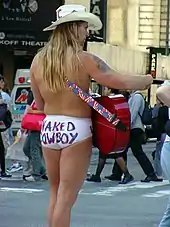
Notable signage includes the Toshiba billboard directly under the NYE ball drop, the curved seven-story NASDAQ sign at the NASDAQ MarketSite at 4 Times Square on 43rd Street, and the curved Coca-Cola sign located underneath another large LED display owned and operated by Samsung. Both the Coca-Cola sign and Samsung LED displays were built by LED display manufacturer Daktronics. Times Square's first environmentally friendly billboard powered by wind and solar energy was first lit on December 4, 2008.[103] On completion, the 20 Times Square development will host the largest LED signage in Times Square at 18,000 square feet.[104] The display will be 1,000 square feet larger than the Times Square Walgreens display and one of the largest video-capable screens in the world.[105]
2000s–present
In 2002, New York City mayor Rudy Giuliani administered the oath of office to the city's next mayor, Michael Bloomberg, at Times Square after midnight on January 1 as part of the 2001–02 New Year's celebration. Approximately 500,000 revelers attended. Security was high following the September 11 terrorist attacks in 2001, with more than 7,000 New York City police officers on duty in the Square, twice the number for an ordinary year.[106]
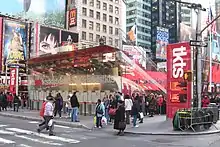
Times Square started hosting other major annual events in the 2000s. Since 2002, the summer solstice has been marked by "Mind over Madness", a mass yoga event involving up to 15,000 people. Tim Tompkins, a co-founder of the event, said part of its appeal was "finding stillness and calm amid the city rush on the longest day of the year".[107][108] Architect Mark Foster Gage proposed and designed the original Times Square Valentine's Day heart in 2009. Since then, designing the heart has become an annual competition.[109][110]
In February 2011, Times Square became smoke-free as New York extended the outdoors smoking ban to the area. The measure imposed a $50 fine for any person caught smoking within the area.[111]
From January 29 to February 1, 2014, a "Super Bowl Boulevard" was held on Broadway, especially in Times Square, between 34th and 47th Streets, as part of Super Bowl XLVIII. The boulevard contained activities such as autographs, a 60 feet (18 m)-high toboggan run, and photographs with the Vince Lombardi Trophy.[112][113][114] The area was under increased security and witnessed over 400,000 people during the period.[115] A proposal to erect a gambling casino was submitted in October 2022 jointly by casino operator Caesars Entertainment and commercial property developer SL Green; the proposal is pending approval from the State of New York.[19]
Pedestrian plaza
On February 26, 2009, Mayor Michael Bloomberg announced that traffic lanes along Broadway from 42nd Street to 47th Street would be de-mapped starting Memorial Day 2009 and transformed into pedestrian plazas as a trial until at least the end of the year. The same was done in Herald Square from 33rd to 35th Street. The results were to be closely monitored to determine if the project was successful and should be extended.[116] Bloomberg also stated that he believed the street shutdown would make New York more livable by reducing pollution, cutting down on pedestrian-vehicle accidents, and helping traffic flow more smoothly through the Midtown street grid.[117]
The pedestrian plaza project was originally opposed by local businesses, who thought that closing the street to cars would hurt business.[118] The original seats put out for pedestrians were inexpensive multicolored plastic lawn chairs, a source of amusement to many New Yorkers; they lasted from the onset of the plaza transformation until August 14, 2009, when they were ceremoniously bundled together in an installation christened Now You See It, Now You Don't by the artist Jason Peters, and shortly afterward were replaced by sturdier metal furniture.[119] Although the plaza had mixed results on traffic in the area, injuries to motorists and pedestrians decreased, fewer pedestrians were walking in the road, and the number of pedestrians in Times Square increased.[120] On February 11, 2010, Bloomberg announced that the pedestrian plazas would become permanent.[121]
The city started rebuilding the plaza in 2010, hiring the design and landscaping firm Snøhetta to permanently replace Broadway's roadway with custom-made granite pavers and benches.[122] By December 2013, the first phase of the Times Square pedestrian plaza had been completed at the southern end of the square in time for the Times Square Ball drop on New Year's Eve.[123] The project was originally intended to be completed by the end of 2015.[123] The entire project was finally completed just before New Year's Eve 2016.[124] Some safety bollards were also installed as part of the renovation to prevent vehicular attacks or collisions on the sidewalk.[125] After a 2017 vehicle-ramming attack, there were calls to install more bollards along Times Square.[126]
Times Square's pedestrian plaza is frequented by topless women (with painted breasts) called "desnudas", as well as costumed characters, who typically panhandle for tips.[127] The pedestrian plaza became a source of controversy in the summer of 2015 because of a large number of complaints about the topless women and panhandling characters.[128] Although neither of these activities was illegal, opponents believed that the panhandlers' presence was detrimental to the quality of life in the area.[129] There were calls from Police Commissioner Bratton and Mayor Bill de Blasio to remove the plaza, although Manhattan Borough President Gale Brewer opposed the proposal.[129] In June 2016, work started on "pedestrian flow zones" where no one was allowed to loiter, as well as "activity zones" where costumed characters were allowed to perform.[130]
Incidents
There have been several incidents in Times Square:
- On the morning of March 6, 2008, a small bomb caused minor damage, but there were no reported injuries.[131]
- On May 1, 2010, Times Square was evacuated from 43rd to 46th Streets following the discovery of a car bomb. It was found to be a failed bombing.[132]
- On May 18, 2017, a vehicle-ramming attack at Times Square killed one person and injured 22 others.[133][134]
- On August 7, 2019, shortly after the shootings in El Paso, Texas, and Dayton, Ohio, a backfiring motorcycle resulted in a stampede due to the sound being mistaken for gunfire; the stampede injured at least twelve people.[135]
- On May 8, 2021, a dispute between a group of men led to a shooting in which three bystanders were wounded, including a four-year-old girl.[136]
- On June 27, 2021, a dispute between a group of street vendors led to a shooting in which a 21-year-old bystander was wounded.[137][138]
Number of visitors
Times Square is the most visited place globally with 360,000 pedestrian visitors a day, amounting to over 131 million a year.[139] As of 2013, it had a greater attendance than do each of the Disney theme parks worldwide, with 128,794,000 visitors between March 2012 and February 2013, versus 126,479,000 for the Walt Disney World theme parks in Bay Lake, Florida, in 2012.[139][140] Even excluding residents from the visitor count, Times Square is the world's second most visited tourist attraction, behind the Las Vegas Strip.[141] The high level of pedestrian traffic has resulted in $4.8 billion in annual retail, entertainment, and hotel sales,[142] with 22 cents out of every dollar spent by visitors in New York City being spent within Times Square.[142][143]
New Year's Eve celebrations
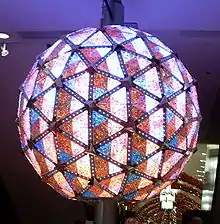
Times Square is the site of the annual New Year's Eve ball drop. About one million revelers crowd Times Square for the New Year's Eve celebrations, more than twice the usual number of visitors the area usually receives daily.[144] However, for the millennium celebration on December 31, 1999, published reports stated approximately two million people overflowed Times Square, flowing from Sixth Avenue to Eighth Avenue and back on Broadway and Seventh Avenue to 59th Street, making it the largest gathering in Times Square since August 1945 during celebrations marking the end of World War II.[145]
On December 31, 1907, a ball signifying New Year's Day was first dropped at Times Square,[146] and the Square has held the main New Year's celebration in New York City ever since. On that night, hundreds of thousands of people congregate to watch the Waterford Crystal ball being lowered on a pole atop the building, marking the start of the new year. It replaced a lavish fireworks display from the top of the building that was held from 1904 to 1906 but stopped by city officials because of the danger of fire. Beginning in 1908, and for more than eighty years thereafter, Times Square sign maker Artkraft Strauss was responsible for the ball-lowering. During World War II, a minute of silence, followed by a recording of church bells pealing, replaced the ball drop because of wartime blackout restrictions. Today, Countdown Entertainment and One Times Square handle the New Year's Eve event in conjunction with the Times Square Alliance.[146] A new energy-efficient LED ball debuted for the arrival of 2008, which was the centennial of the Times Square ball drop. The 2008–09 ball is larger and has become a permanent installation as a year-round attraction, being used for celebrations on days such as Valentine's Day and Halloween.[146]
The New Year's Eve celebrations are usually overseen by thousands of police officers. Aluminum barriers are erected to accommodate spectators; for the 2020 celebration, attended by a million people, barriers were erected from 38th to 59th Street and from Sixth to Eighth Avenue.[147] Typically, the celebrations create large amounts of waste. The New York City Department of Sanitation estimated that by 8 a.m. on New Year's Day 2014, it had cleared over 50 short tons (45 long tons; 45 t) of trash from the New Year's celebration, using 190 workers from their crews and the Times Square Alliance.[148]
Impact of COVID-19
The onset of the COVID-19 pandemic in New York City during 2020 reduced the number of people traveling to Times Square. About 108,000 pedestrians visited Times Square each day in late 2020 compared to the 380,000 before the pandemic. From March to October 2020, 26 of the area's 46 hotels closed, as well as 39 of 151 stores and 84 of 162 restaurants.[149] Times Square was closed to the public for New Year's Day 2021 and observers were dispersed into enclosures measuring 8 by 8 feet (2.4 by 2.4 m).[147][150]
Notable landmarks
Times Square is a busy intersection of art and commerce, where scores of advertisements – electric, neon and illuminated signs and "zipper" news crawls – vie for viewers' attention. Notable examples include:
- Coca-Cola sign
- Disney Store
- Fashion One
- Forever 21 (formerly Virgin Megastores)
- Hard Rock Cafe New York
- M&M's World
- MTV
- Planet Hollywood
- Palladium Times Square
- Revlon
- Times Square Studios – used primarily for selected ABC News and ESPN programs, such as Good Morning America
- TKTS – the Theatre Development Fund's reduced-price ticket booth has, since 2008, been backed by a red, sloped, triangular set of bleacher-like stairs, which is frequented by residents and tourists.
- Times Square - a permanently installed sound art piece by Max Neuhaus between 45th and 46th Streets.
|
Major buildings on or near Times Square
|
"Numbered" Times Square buildings
Hotels
|
Corporate presence
|
Contemporary artists regularly perform on Times Square. Examples include test patterns[times square] by Ryoji Ikeda[157] and Continuum by Krista Kim.[158]
In popular culture
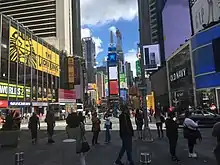
An immediately recognizable location, Times Square has been featured countless times in literature, films, video games, music videos, and on television.
The seediness of the area was featured prominently in such films as Midnight Cowboy[159] (1969), Born to Win[160] (1971), and Taxi Driver (1976).[161] The area was shown in the 1980 film Times Square, which featured a punk rock/new wave soundtrack.[162] It was also depicted in the 2011 movie New Year's Eve.[163] The area also appeared on The Amazing Race as the starting location in a race around the world in the first episode of the show's 25th season,[164] as well as on the sixth season of the Israeli edition of The Amazing Race with teams finishing their second leg in Times Square.[165]
Times Square has been fictionally attacked and destroyed in several movies, including Knowing, when a solar flare destroys New York City;[166] Deep Impact, when a tsunami created from a meteor impact destroys New York City; the 1998 film Godzilla, where Godzilla is chased through the square; the Ghostbusters movies; Stephen King's The Stand, where the intersection is overcome by total anarchy; Transformers: Revenge of the Fallen, and Cloudy with a Chance of Meatballs. It was also seen in the festival battle scene in the 2002 film Spider-Man, and a stand-off in the later film The Amazing Spider-Man 2.[167]
Films and TV shows have also employed the opposite tactic, depicting the typically bustling area as eerily still, such as in Vanilla Sky,[168] as well as the post-apocalyptic I Am Legend, in which Will Smith and his dog go hunting for deer in the deserted urban canyon.[166] In the pilot episode of the TV series Blindspot, Times Square is completely emptied due to an abandoned bag being suspected to be a bomb.[169]
Times Square also has featured prominently in video games. For instance, in Grand Theft Auto IV, a recreation of the Times Square area referred to in-game as "Star Junction", is included in the game's fictional "Liberty City" setting.[166] Times Square is also shown in Battlefield 3, where the final fight with the main antagonist takes place, where the player must stop him from detonating a nuclear bomb in the square; and Crysis 2, in which player must fight off attacking alien forces to assist U.S. Marines in evacuating the area.[170] Gran Turismo 4 also features Times Square both as a photo spot and as a part of the New York city circuit which also includes Central Park.
See also
- Duffy Square, the northern section of Times Square between 45th and 47th Streets[171]
- Good Riddance Day, an unofficial holiday celebrated at Times Square since 2007[172]
- Midtown Community Court, a branch of the New York City Criminal Court that primarily focuses on quality of life around Times Square[173]
- Naked Cowboy, New York City street performer and prominent fixture of Times Square[174]
- Theater District, Manhattan[175]
- Times Square – 42nd Street / Port Authority Bus Terminal subway station serving the 1, 2, 3, 7, <7>, A, C, E, N, Q, R, W, and S (42nd Street Shuttle) trains
- Lincoln Highway, the terminus of which was in Times Square
References
Notes
- Any development under 60,000 square feet (5,600 m2) was exempt from the rule; for larger buildings, the first 50,000 square feet (4,600 m2) of a development was exempt from the bonus calculation. For example, in a building with 500,000 square feet (46,000 m2), the bonus calculation was derived from 5 percent of 450,000 square feet (42,000 m2), so the space to be set aside for entertainment uses was 22,500 square feet (2,090 m2).[58]
Citations
- "NYC Planning | Community Profiles". communityprofiles.planning.nyc.gov. New York City Department of City Planning. Retrieved March 18, 2019.
- Allan Tannenbaum. "New York in the 70s: A Remembrance". The Digital Journalist. Retrieved January 21, 2012.
- Explore Manhattan Neighborhoods: The Center of the Universe (aka Times Square). Her Campus (March 22, 2011). Retrieved on August 17, 2013.
- Federal Writers' Project (1939). New York City Guide. New York: Random House. p. 170. ISBN 978-1-60354-055-1. (Reprinted by Scholarly Press, 1976; often referred to as WPA Guide to New York City.) "The phrase 'Great White Way' is supposed to have been coined in 1901 by O. J. Gude, an advertising man, who is said also to have been the first to see the tremendous possibilities of electric display."
- Tell, Darcy. Times Square spectacular: lighting up Broadway New York: HarperCollins, 2007
- Allen, Irving Lewis. The City in Slang: New York Life and Popular Speech. New York: Oxford University Press, 1995. Quote: "By 1910, the blocks of Broadway just above 42nd Street were at the very heart of the Great White Way. The glow of Times Square symbolized the center of New York, if not of the world."
- Noah Remnick and Tatiana Schlossberg (August 24, 2015). "New York Today:Transforming Times Square". The New York Times. Retrieved August 24, 2015.
- "The Most Jivin' Streetscapes in the World". Luigi Di Serio. 2010. Archived from the original on September 21, 2014. Retrieved January 21, 2012.
- "Times Square". Encyclopædia Britannica. Retrieved January 21, 2012.
- "New York Architecture Images- Midtown Times Square". 2011 nyc-architecture. Archived from the original on January 25, 2017. Retrieved January 21, 2012.
- Ann Shields (November 10, 2014). "The World's 50 Most Visited Tourist Attractions – No. 3: Times Square, New York City – Annual Visitors: 50,000,000". Travel+Leisure. Retrieved May 6, 2015.
- Owen, David (January 21, 2013). "The Psychology of Space". The New Yorker. Retrieved February 21, 2022.
- Hellman, Peter (May 19, 1997). "Bright Lights, Big Money". New York Magazine. Vol. 30, no. 19. New York Media, LLC. p. 48. ISSN 0028-7369.
- "Facts and Figures: Annual Subway Ridership 2014–2019". Metropolitan Transportation Authority. 2020. Retrieved May 26, 2020.
- Times Square History, NYC Tourist. Accessed February 26, 2017. "Times Square is a major commercial intersection in central Manhattan at the junction of Broadway and Seventh Avenue. It acquired its name in 1904 when Albert Ochs, publisher of The New York Times, moved the newspaper's headquarters to a new skyscraper on what was then known as Longacre Square."
- Dunlap, David W. "1907-8 | The Times Drops the Ball", The New York Times, January 1, 2015. Accessed November 1, 2016. "After two more years of pyrotechnics, The Times found a less flammable way to signal the moment of midnight: an iron-and-wood ball, five feet in diameter, on which 100 25-watt bulbs were mounted. It was to be lowered down a flagstaff at midnight on Dec. 31, 1907."
- "Times Square - The Official Website". Times Square District Management Association, Inc. May 10, 2017. Retrieved August 4, 2022.
- Chan, Sewell. "A Lincoln Highway Marker in Times Square", The New York Times, February 12, 2009. Accessed January 9, 2022. "Nevertheless, Times Square is indeed the eastern terminus of the Lincoln Highway, the nation’s first coast-to-coast road, which was formed in 1913, its 3,389 miles stretching from New York City to San Francisco."
- Dana Rubinstein, Nicole Hong, and Michael Paulson (October 19, 2022). "Times Square May Get One of the Few Spectacles It Lacks: A Casino". The New York Times. Retrieved October 21, 2022.
{{cite news}}: CS1 maint: multiple names: authors list (link) - "Times Square is not a square," Urban Magazine (May 9, 2011).
- Rybczynski, Witold. City Life: Urban Expectations in a New World New York: Scribner, 1995. p.27. ISBN 0-684-81302-5. Quote: "...despite its name [Times Square] is really a street intersection, not a square."
- Dunlap, David W. "COMMERCIAL PROPERTY: Times Square Novelty; North of Duffy Sq., a Butler-on-Every-Floor Hotel", The New York Times, June 10, 1990. Accessed February 26, 2017. "With its hot nightclubs, dazzling signs and sprawling showrooms, the block at the northern end of the 'bowtie' formed by Broadway and Seventh Avenue was always an important part of old Times Square."
- "Times Square" New York City Geographic Information Service map
- Harris, Stephen L. Duffy's War: Fr. Francis Duffy, Wild Bill Donovan, and the Irish Fighting 69th in World War I, Potomac Books, 2006
- Gerard T. Koeppel, Water for Gotham: A History, 2001:10.
- Sanderson, Eric W. Mannahatta: A Natural History of New York City, 2009: Appendix A p 253; refs. G.E. Hill and G.E. Waring Jr, "Old wells and water-courses on the isle of Manhattan", in Historic New York, M.W. Goodwin, A.C. Royce, and R. Putnam, 1897; and others.
- Edwin G. Burrows and Mike Wallace, Gotham: A History of New York City to 1898, 1999, p.721.
- Ulam, Alex (June 2, 2008). "John Jacob Astor: The making of a hardnosed speculator | The Real Deal | New York Real Estate News". The Real Deal. Archived from the original on February 15, 2010. Retrieved April 21, 2010.
- Kelly, Frank Bergen. Historical Guide to the City of New York New York: Frederick A. Stokes Co., 1909
- Stavrou, Gene. "Where was the American Horse Exchange? – TreebaseNYC". www.treebase.com. Archived from the original on February 3, 2016. Retrieved January 25, 2016.
- Dunning, Jennifer. "A Walking Tour of the Past and Present on Broadway", The New York Times, July 13, 1979. Accessed November 1, 2016. "The old stock and repertory company system made way for the Broadway hit and greater profits for the theater manager and owner, which, in turn, led to the rise of such theatrical entrepreneurs as Oscar Hammerstein, who struck out into the wilds of 44th and 45th Streets in 1895 to build his huge Olympia Theater in the 'Thieves Lair' area of Broadway."
- Burrows and Wallace 1999:1149.
- Gray, Christopher. "Streetscapes: A Small Hotel, a Mock Battleship and the Titanic", The New York Times, December 1, 1996. Accessed November 1, 2016. "Q The Pabst Hotel was on the site of the old New York Times Tower, at the northwest corner of 42d and Broadway. Was it owned and operated by Pabst Brewing? . . . David Steigerwald, Fanwood, N.J.A Yes. The Pabst opened in November 1899, in the middle of the first wave of theater construction to arrive in the area, then known as Longacre Square."
- Barron, James. "100 Years Ago, an Intersection's New Name: Times Square", The New York Times, April 8, 2004. Accessed May 26, 2017.
- "Times Square – New York, New York – Scenic at Night on". Waymarking.com. Retrieved April 21, 2010.
- WINTER GARDEN, Theatre District, Forgotten New York, February 2, 2016. Accessed May 26, 2017.
- Ennis, Thomas W. "OLD TIMES TOWER TO GET NEW FACE", The New York Times, April 17, 1963. Accessed February 21, 2022.
- "The Lincoln Highway Marker". Hmdb.org. Retrieved April 21, 2010.
- Pollak, Michael. "A Highway’s Starting Line, and a Flemish Firehouse", The New York Times, July 8, 2016. Accessed November 1, 2016. "The sign, which has been restored to the northeast corner of 42nd Street and Broadway, is quite authentic. It was placed there on Feb. 12, 2009, the 200th anniversary of Abraham Lincoln's birth, to mark the Lincoln Highway, which was created in 1913 and was the nation's first coast-to-coast road."
- Leach, William R. Land of Desire: Merchants, Power, and the Rise of a New American Culture, p. 339, Knopf Doubleday Publishing Group, 2011, ISBN 9780307761149. Accessed May 26, 2017.
- Leach (1993), p.340
- Leach (1993), p.341
- Leach (1993), p.345
- Leach (1993), p.346
- "Killer Cop: Charles Becker – Crime Library on". TruTV. Archived from the original on December 12, 2013. Retrieved April 21, 2010.
- Macbeth, VR (May 1, 2012). "The Great White Way". Timessquare.com. Archived from the original on May 4, 2011.
- "From Dazzling to Dirty and Back Again: A Brief History of Times Square". History of Times Square. Times Square District Management Association. May 17, 2017. Retrieved July 23, 2021.
{{cite web}}: CS1 maint: url-status (link) - "V-E Day". University of San Diego. Archived from the original on May 15, 2008. Retrieved May 9, 2016.
- "Victory Celebrations". Life. August 27, 1945. p. 21. Retrieved November 25, 2011.
- "Times Square New York City". Streetdirectory.com. Retrieved April 21, 2010.
- Bracker, Milton (March 14, 1960). "Life on W. 42d St. A Study in Decay". The New York Times. ISSN 0362-4331. Retrieved April 8, 2022.
- "Sex Business in Times Square Said to Decrease". The New York Times. May 31, 1984. ISSN 0362-4331. Retrieved April 8, 2022.
- Farley, David (June 25, 2018). "The curious history of Times Square – and why you should visit, despite the chaos". The Telegraph. Retrieved April 8, 2022.
- Stern, William J. (December 23, 2015). "The Unexpected Lessons of Times Square's Comeback". City Journal. Retrieved April 8, 2022.
- Traub, James. The Devil's Playground: A Century of Pleasure and Profit in Times Square, New York: Random House, 2004. ISBN 0375759786.
- Gottlieb, Martin (November 1, 1986). "Surge of Times Sq. Projects Raises Questions on Effects". The New York Times. ISSN 0362-4331. Archived from the original on February 10, 2022. Retrieved February 14, 2022.
- Oser, Alan S. (December 14, 1986). "Perspectives: Great White Way; Planning for a Brighter Times Sq". The New York Times. ISSN 0362-4331. Archived from the original on February 14, 2022. Retrieved February 14, 2022.
- Dunlap, David W. (September 3, 1987). "New Rule for Times Sq. Space". The New York Times. ISSN 0362-4331. Archived from the original on February 10, 2022. Retrieved February 10, 2022.
- Light, Larry; Meehan, John (July 2, 1990). "Finance: real estate: the walls keep closing in on New York developers". Bloomberg Businessweek. No. 3167. p. 72. ProQuest 236695270.
- Stern, Fishman & Tilove 2006, p. 663.
- Lueck, Thomas J. (March 4, 1990). "Battling for Tenants in a Slow Market". The New York Times. ISSN 0362-4331. Archived from the original on February 11, 2022. Retrieved February 11, 2022.
- Dunlap, David W. (August 26, 1990). "Commercial Property: Vacancy Rates; Black Monday's Fallout: An Emptiness Downtown". The New York Times. ISSN 0362-4331. Archived from the original on August 21, 2021. Retrieved February 10, 2022.
- Bartlett, Sarah (March 4, 1992). "Media Group Makes a Deal For Building". The New York Times. ISSN 0362-4331. Archived from the original on December 17, 2019. Retrieved February 10, 2022.
- Henry, David (March 4, 1992). "A New Player on Times Square". Newsday. pp. 52, 55. Archived from the original on February 10, 2022. Retrieved February 10, 2022 – via newspapers.com.
- Gelbtuch, Howard (February 19, 1996). "The ground floor: The times they are a changin' in Times Square and early investors get bargains". Barron's. Vol. 76, no. 8. p. 48.1. ProQuest 200987811.
- Grant, Peter (September 6, 1993). "Times Square's time has come". Crain's New York Business. Vol. 9, no. 36. p. 11. ProQuest 219117979.
- Pinder, Jeanne B. (August 12, 1993). "Midtown Building Is Sold for Lofty $176 Million". The New York Times. ISSN 0362-4331. Archived from the original on February 15, 2022. Retrieved February 15, 2022.
- Grant, Peter (May 9, 1994). "IBM gets record price for NY headquarters". Crain's New York Business. Vol. 10, no. 19. p. 1. ProQuest 219127068.
- Lueck, Thomas J. (February 14, 1988). "The Region: Redevelopment; Times Square Plan Takes A Shaky Step Forward". The New York Times. ISSN 0362-4331. Archived from the original on September 17, 2021. Retrieved September 17, 2021.
- Stephens, Suzanne (March 2000). "Four Times Square" (PDF). Architectural Record. Vol. 188. p. 92. Archived (PDF) from the original on September 29, 2021. Retrieved October 1, 2021.
- Dunlap, David W. (August 3, 1992). "Long Delay Likely in Rebuilding Plan for Times Square". The New York Times. ISSN 0362-4331. Archived from the original on September 17, 2021. Retrieved September 17, 2021.
- Stern, Fishman & Tilove 2006, pp. 690–691.
- "Metro Datelines; Times Sq. Gets New Partner". The New York Times. October 8, 1986. ISSN 0362-4331. Archived from the original on September 17, 2021. Retrieved September 17, 2021.
- Polsky, Carol (October 8, 1986). "Prudential Company Joins Times Square". Newsday. p. 20. Archived from the original on September 17, 2021. Retrieved September 17, 2021 – via newspapers.com.
- Stern, Fishman & Tilove 2006, p. 645.
- David W. Dunlap (January 7, 2015). "With a Friendlier 42nd Street, Mario Cuomo Left His Mark on Times Square". The New York Times. Retrieved January 8, 2015.
- Dunlap, David W. (November 9, 1991). "Times Square Redevelopers Seek Delay in Project". The New York Times. ISSN 0362-4331. Archived from the original on September 17, 2021. Retrieved September 17, 2021.
- Henry, David (August 4, 1992). "Remodeling Times Square, Part IV". Newsday. p. 27. Archived from the original on September 17, 2021. Retrieved September 17, 2021 – via newspapers.com.
- Pulley, Brett (November 21, 1995). "Key Developer Seeks a Role In Times Sq". The New York Times. ISSN 0362-4331. Archived from the original on September 17, 2021. Retrieved September 17, 2021.
- Dunlap, David W. (September 16, 1993). "Choreographing Times Sq. Into 21st Century". The New York Times. ISSN 0362-4331. Archived from the original on September 17, 2021. Retrieved September 17, 2021.
- Bagli, Charles V.; Kennedy, Randy (April 5, 1998). "Disney Wished Upon Times Sq. And Rescued a Stalled Dream". The New York Times. ISSN 0362-4331. Archived from the original on September 25, 2021. Retrieved September 25, 2021.
- "Times Square Alliance". Archived from the original on March 4, 2010.
- "Times Square BID Unveils New Visitors Center; Opens to Public Sept. 2". Playbill. December 30, 1997. Retrieved January 2, 2022.
- "Embassy 1 Theatre in New York, NY". Cinema Treasures. August 26, 1925. Retrieved January 2, 2022.
- Macek, Steve (2006). Urban Nightmares: The Media, the Right, And the Moral Panic Over the City. Minneapolis: University of Minnesota Press. p. 111. ISBN 9780816643608.
- Rofes, Eric E. (2001). "Imperial New York: Destruction and Disneyfication under Emperor Giuliani. Review of Times Square Red, Times Square Blue. Samuel R. Delany. New York: New York University Press, 1999". GLQ: A Journal of Lesbian and Gay Studies. 7 (1): 101–09. doi:10.1215/10642684-7-1-101. S2CID 144081737.
- Bagli, Charles V.; Kennedy, Randy (April 5, 1998). "Disney Wished Upon Times Sq. and Rescued a Stalled Dream". The New York Times. ISSN 0362-4331. Retrieved May 15, 2017.
- Stern, Fishman & Tilove 2006, p. 719.
- Bagli, Charles V. (March 31, 1998). "2 Developers Bid Top Dollar For What's Left in Times Sq". The New York Times. ISSN 0362-4331. Archived from the original on September 27, 2021. Retrieved September 27, 2021.
- Lueck, Thomas J. (April 12, 1996). "Developer Buys the Rights to Build a Times Square Tower". The New York Times. ISSN 0362-4331. Archived from the original on September 17, 2021. Retrieved September 17, 2021.
- Lueck, Thomas J. (May 8, 1996). "Conde Nast Is to Move to a New Times Square Tower, Officials Say". The New York Times. ISSN 0362-4331. Archived from the original on September 18, 2021. Retrieved September 25, 2021.
- Bagli, Charles V. (September 6, 1997). "Reuters to Build 32-Story Headquarters in Times Sq". The New York Times. ISSN 0362-4331. Archived from the original on September 25, 2021. Retrieved September 25, 2021.
- Grant, Peter (September 8, 1997). "Reuters' new tower will get Rudin byline". New York Daily News. p. 27. Archived from the original on September 25, 2021. Retrieved September 25, 2021 – via newspapers.com.
- "Reuters Opens New HQ in Heart of City". Newsday. June 5, 2001. p. 47. Archived from the original on September 27, 2021. Retrieved September 27, 2021 – via newspapers.com.
- "Blackstone Partnership To Buy Times Square Sites". The Wall Street Journal. April 1, 1998. p. C22. ISSN 0099-9660. ProQuest 398611537.
- Standora, Leo (March 31, 1998). "Last 2 major Times Sq. sites go in 300M deal". New York Daily News. p. 6. Archived from the original on September 28, 2021. Retrieved September 28, 2021 – via newspapers.com.
- "Leasing". Real Estate Forum. Vol. 58, no. 2. February 2003. p. 22. ProQuest 216569107.
- Boss, Shira J. (June 24, 2002). "Moving industry packs punch". Crain's New York Business. Vol. 18, no. 25. p. 1. ProQuest 219202175.
- Elliott, Stuart (July 1, 2004). "The Media Business: Advertising; Target is putting its bull's-eyes on Times Square Tower". The New York Times. ISSN 0362-4331. Archived from the original on September 29, 2021. Retrieved September 29, 2021.
- "Zoning Resolution 81-732". City of New York. Retrieved October 8, 2021.
- Oser, Alan S. (December 14, 1986). "Great White Way; Planning for a Brighter Times Sq". The New York Times. Retrieved August 22, 2009.
- "Architect Robert A.M. Stern: Presence of the Past" (PBS video) on the Arch Daily website
- Collins, Glenn (November 14, 2008). "In Times Square, a Company's Name in (Wind- and Solar-Powered) Lights". The New York Times. Retrieved August 22, 2009.
- Barbarino, Al. "Ian Schrager Taps CBRE for 20 Times Square Retail". Commercial Observer. (May 21, 2014)
- Collins, Glenn (May 24, 2008). "How to Stand Out in Times Square? Build a Bigger and Brighter Billboard". The New York Times. Retrieved January 14, 2013.
- "Text of Bloomberg's Inaugural Address". The New York Times. January 1, 2002. Retrieved April 21, 2010.
- "Times Square takes yoga time-out on summer solstice at BBC News". BBC News. June 21, 2013. Retrieved October 4, 2014.
- "Solstice in Times Square: Athleta Mind Over Madness Yoga". Retrieved October 4, 2014.
- Lee, Jennifer (February 10, 2009). "The Pulsing Heart of Times Square". New York Times. Retrieved March 19, 2019.
- Johnson, Sara (February 13, 2014). "6 Years of Times Square Valentines". Architect. Retrieved March 19, 2019.
- Pilkington, Ed (February 3, 2011). "Times Square becomes smoke free as New York extends ban outdoors". Guardian. London. Retrieved February 3, 2011.
- "Times Square Alliance : Super Bowl Boulevard". Times Square Alliance. Archived from the original on November 10, 2013. Retrieved January 28, 2014.
- "Finishing Touches Being Put on Super Bowl Boulevard". NY1. Archived from the original on January 29, 2014. Retrieved January 28, 2014.
- "Super Bowl Blvd. starting to take shape – New York News". WNYW. Archived from the original on January 29, 2014. Retrieved January 28, 2014.
- Celona, Larry (January 27, 2014). "NYPD plans high security on Super Bowl Boulevard". New York Post. Retrieved January 28, 2014.
- Seifman, David (February 26, 2009). "Broadway Cars Can Take A Walk". New York Post. Retrieved February 21, 2022.
- Vanderford, Richard; Goldsmith, Samuel (May 25, 2009). "Walk, bike or sit, car-free, in Times Square and Herald Square". New York Daily News. Archived from the original on May 26, 2009. Retrieved February 21, 2022.
- Citing "Livability and Mobility," Bloomberg Declares Broadway Plazas a Success. Next City Retrieved on February 21, 2022.
- Noel Y.C. (August 16, 2009). "Jason Peters' Now You See It, Now You Don't – Lawn Chair Sculpture". NYC ♥ NYC. Retrieved February 21, 2022.. See also: Media:NowYouSeeIt-TimesSq2009.JPG.
- Nyc Dot. Nyc.gov. Retrieved on August 17, 2013.
- "Pedestrian Plaza To Remain Permanent Fixture of Times Square". NY1.com. March 30, 2010. Archived from the original on February 14, 2010. Retrieved April 21, 2010.
- "Times Square Reconstruction". Snøhetta. Archived from the original on December 8, 2013. Retrieved December 29, 2016.
- "Snohetta Makes Times Square Permanently Pedestrian". ArchDaily. January 9, 2014. Retrieved December 29, 2016.
- Evans, Dave (December 28, 2016). "Times Square reconstruction finished just before New Year's Eve". ABC7 New York. Retrieved December 29, 2016.
- Blumenthal, Eli (May 18, 2017). "What stopped the car in Times Square? A closer look at bollards". USA TODAY. Retrieved May 20, 2017.
- "Times Square mayhem raises question about recent redesign". Reuters. May 19, 2017. Retrieved May 20, 2017.
- Blitzer, Jonathan (June 26, 2014). "Being a Times Square Elmo". The New Yorker. Retrieved May 15, 2017.
- Dunlap, David W. (August 23, 2015). "Debating Value of Pedestrian Plazas Beyond New York City". The New York Times. Retrieved August 24, 2015.
- Barkan, Ross (August 24, 2015). "Manhattan Beep Calls Plan to Tear Up Times Square Pedestrian Plaza 'Preposterous'". Observer. Retrieved August 24, 2015.
- "Elvis, Elmo Bummed by City's New Times Square Flow Zones". NBC New York.
- BBC News March 6, 2008
- Baker, Al; Rashbaum, William K. (May 1, 2010). "Police Find Car Bomb in Times Square". The New York Times.
- Sanchez, Ray (May 18, 2017). "Times Square car incident: 1 dead, 22 injured; driver in custody". CNN. Retrieved May 18, 2017.
- Rosenberg, Eli; Rashbaum, William K. (May 18, 2017). "One Dead and 22 Injured as Car Rams into Pedestrians in Times Square". The New York Times. Retrieved May 18, 2017.
- Gajanan, Mahita (August 7, 2019). "Mistaking Motorcycles Backfiring as Gunshots, Crowds Flee Times Square Causing Stampede, Injuries". Time. Retrieved August 9, 2019.
- Ly, Laura; Waldrop, Theresa; Snyder, Alec (May 9, 2021). "Two women and a 4-year-old girl wounded in Times Square shooting, NYPD says". CNN. Retrieved May 9, 2021.
- Watkins, Ali; Wong, Ashley (June 28, 2021). "Police Officers Will 'Flood' Times Square After Another Bystander Is Shot". The New York Times. ISSN 0362-4331. Retrieved July 1, 2021.
- Chapman, Ben; Honan, Katie (June 28, 2021). "NYPD Adds Patrols in Times Square After Tourist Is Shot". The Wall Street Journal. ISSN 0099-9660. Retrieved July 1, 2021.
- "Times Square Pedestrian Counts, Times Square Alliance". Retrieved October 4, 2014.
- Global Attractions Attendance Report, TEA/AECOM, Published June 10, 2013.
- "The World's 50 Most Visited Tourist Attractions". HuffPost. February 26, 2014. Retrieved February 21, 2022.
- Times Square Economic Impact Update, Times Square Alliance / HRA, March 2012
- "New York City Tourism: A Model for Success, NYC and Company, 2013" (PDF).
- "Times Square Alliance – New Year's Eve". Timessquarenyc.org. Archived from the original on January 14, 2013. Retrieved April 21, 2010.
- "Times Square New York City, New York City Times Square". Timessquare.nyctourist.com. Archived from the original on February 17, 2010. Retrieved April 21, 2010.
- "Times Square Alliance – New Year's Eve – About The Ball". Timessquarenyc.org. November 11, 2008. Archived from the original on October 11, 2011. Retrieved April 21, 2010.
- Gold, Michael (December 30, 2020). "No Crowds, but Times Square Ball Drop Is Still Happening. Here's How". The New York Times. ISSN 0362-4331. Retrieved March 27, 2021.
- "Crews Clean Up Times Square After New Year's Celebration". CBS New York. January 1, 2014. Retrieved December 30, 2014.
- Kilgannon, Corey (December 1, 2020). "Without Crowds, Is Times Square Really Times Square? Take a Look". The New York Times. ISSN 0362-4331. Retrieved July 1, 2021.
- Fastenberg, Dan; Allen, Jonathan (December 31, 2020). "After a year like no other, New York's Times Square empties out on New Year's Eve". Reuters. Retrieved March 27, 2021.
- White, Norval & Willensky, Elliot (2000). AIA Guide to New York City (4th ed.). New York: Three Rivers Press. ISBN 978-0-8129-3107-5.
- "One Times Square". CTBUH Skyscraper Database. Council on Tall Buildings and Urban Habitat. 2016. Archived from the original on November 17, 2016.
- "The Reuters Building". Wired New York. Archived from the original on December 2, 2010. Retrieved April 21, 2010.
- "4 Times Square - The Skyscraper Center". Council on Tall Buildings and Urban Habitat. Retrieved September 18, 2021.
- "5 Times Square - The Skyscraper Center". The Skyscraper Center. April 7, 2016. Retrieved September 28, 2021.
- Muto, Sheila (September 5, 2001). "What's in an Address? Sometimes, a Better Image: Office Buildings Take On Street Names, Numbers With Greater Appeal". The Wall Street Journal. p. B14. ISSN 0099-9660. ProQuest 2074372587.
- "Ryoji Ikeda Presents: test pattern". Fact Magazine. May 4, 2021. Retrieved April 30, 2022.
- "Daily digest: Nick Cave will project onto theMART, waves of soothing color in Times Square, and more". The Architect’s Newspaper. February 25, 2022. Retrieved April 30, 2022.
- "Midnight Cowboy Film Locations". On the Set of New York. Retrieved February 14, 2015.
- Tucker, Ken (June 13, 2004). "Times Square at 100; It Outta Be in Pictures". The New York Times. Retrieved December 24, 2019.
- Nigro, Carmen. "The Changing Face of Times Square," New York Public Library: Stephen A. Schwarzman Building, Milstein Division of United States History, Local History and Genealogy (January 12, 2015).
- Times Square, Roger Ebert, November 17, 1980. Accessed October 5, 2016. "The story involves two teen-age runaway girls, an all-night disk jockey and the inhabitants of the Times Square jungle of New York."
- New Year's Eve, Roger Ebert, December 7, 2011. Accessed October 5, 2016. "What sins did poor Hilary Swank commit, that after winning two Oscars, she has to play the role of the woman in charge of the New Year's Eve ball in Times Square?"
- "The Next Season of Amazing Race". CBS. June 1, 2014. Retrieved January 8, 2020.
- Hayun, Omri (May 17, 2017). בלעדי! משתתפי "המירוץ למיליון" נחתו בניו יורק הישר לטיימס סקוור [Exclusive! "Race for a Million" landed in New York straight to Times Square]. Omritv (in Hebrew). Retrieved January 8, 2020.
- Knight, Gladys L. Pop Culture Places: An Encyclopedia of Places in American Popular Culture, p. 870. Accessed October 5, 2016. "In Knowing (2009), the area is one of several iconic places ravaged by a solar flare."
- Giardina, Carolyn. "Amazing Spider-Man 2: An Exclusive Look at the Times Square Battle (Photos)", The Hollywood Reporter, May 2, 2014. Accessed February 21, 2022. "Some of the most complicated visual effects work in Sony's The Amazing Spider-Man 2 can be seen in the action sequence set in Times Square, according to the film's VFX supervisor, Sony Pictures Imageworks.' Jerome Chen."
- Vanilla Sky – Entertainment Tonight, The Uncool. Accessed October 5, 2016. "New York has never shut down Times Square for anything, much less a film crew.... But with the help of the New York Mayor's office, the city's film commission and the New York police Department, the Vanilla Sky crew actually pulled off a total Times Square closure, arranging to clear the entire area for 90 minutes on a Sunday morning in November of 2000."
- Raferty, Liz. "How the Creators of Blindspot 'Shut Down Times Square' for That Crazy Opening Scene", TV Guide, September 21, 2015. Accessed October 5. 2016. "Fast-forward five years, and Gero's vision has come to life in the form of Blindspot, NBC's new drama about a Jane Doe (Jaimie Alexander) who's discovered in a duffel bag in the middle of an evacuated Times Square, covered in tattoos and with no memory of how she got there, who she is, or what's going on in the world around her."
- "Crysis 2 - Mission 14 Power Out - Walkthrough". YouTube. Archived from the original on December 11, 2021. Retrieved July 23, 2021.
- Father Duffy Square, New York City Department of Parks and Recreation. Accessed January 10, 2017. "Dominated in 1909 by a temporary eight-ton, fifty-foot statue by Leo Lentelli entitled Purity (Defeat of Slander), today this square—so central to the theater district—is defined by statues of George M. Cohan and Father Duffy, as well as a large public viewing grandstand along the north side."
- Good Riddance Day, Times Square Alliance. Accessed January 10, 2017. "Good Riddance Day is inspired by a Latin American tradition in which New Year's revelers stuffed dolls with objects representing bad memories before setting them on fire."
- Midtown Community Court, Center for Court Innovation. Accessed January 10, 2017.
- Cowan, Alison Leigh. "Naked Cowboy Drops Out: No Singing Mayor in Briefs", The New York Times, September 4, 2009. Accessed January 10, 2017. "Running for mayor of New York City must have struck Robert Burck, the so-called Naked Cowboy of Times Square, as a good idea back in July."
- Theater District, NYC.com. Accessed January 10, 2017.
Bibliography
- Brown, H. (1922) Valentine's Manual of Old New York. Valentine.
- Fazio, W. (2000) Times Square, Children's Press. ISBN 0-516-26530-X
- Friedman, J. (1993) Tales of Times Square Feral House. ISBN 0-922915-17-2
- Leach, William (1993). Land of Desire. New York: Pantheon Books. ISBN 978-0307761149.
- Stern, Robert A. M.; Fishman, David; Tilove, Jacob (2006). New York 2000: Architecture and Urbanism Between the Bicentennial and the Millennium. New York: Monacelli Press. ISBN 978-1-58093-177-9. OCLC 70267065. OL 22741487M.
- Taylor, W. (1996) Inventing Times Square, Johns Hopkins U. Press. ISBN 0-8018-5337-0
- Traub, James (2004) The Devil's Playground: A Century of Pleasure and Profit in Times Square New York: Random House. ISBN 0-375-50788-4
External links
- Times Square live camera
- The Times Square Alliance and Events Listing
- Times Square 360 panorama
- "The Changing Face of Times Square" at the New York Public Library website
- Times Square Arts Center Archived June 27, 2019, at the Wayback Machine
- NYC-Architecture.com
- New York City Tourist Archived September 19, 2019, at the Wayback Machine
